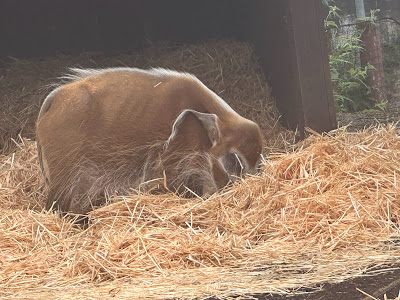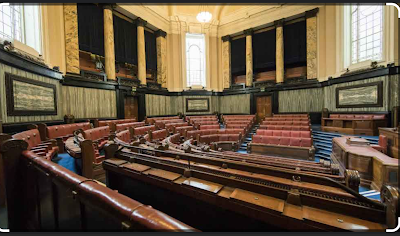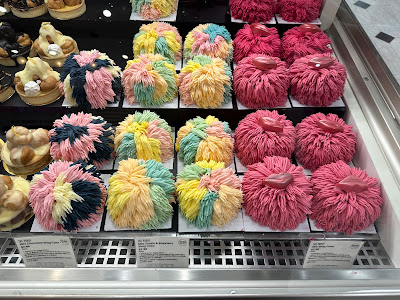The drama of the day was that I lost my key. How I do not know as I always put the key in my pants pocket. The real problem was the Air B&B nightmare: host does not reply to message and the "people at Air&B and B who are always here to help," don't. It got straightened out...after five hours of frustration. I didn't have to sit around and wait the whole time because I had a ticket to Macbeth at the Globe. I left just before intermission, that is how painful the performance was. There was good mood music all eerie and stuff and drums, but the costumes or rather lack thereof, acting, staging, the props, all of it really bad. I expected more from the Brits! I looked up some Reviews to see if I was alone in thinking that this was just about the worst Shakespeare I had ever seen, but although the reviewers are more restrained than I am, most did not exactly love it either. And tonight, as I was texting my host, I mentioned the play, which, he, too, had seen. In that quintessentially British way he summed it up: Pure rubbish!
The Globe Theatre, though, worth the price of admission.
On the way to Hyde Park, one passes Buckingham Palace and the guards must have gone down with Alice because they were not in their little houses:
There were a couple of hard-working security guards on duty:
Hyde Park Rose Garden:
where roses grow up the trees. Would you expect anything less?
And ducks swimming in the lake:
and where everyone is busy getting all preened up for the day (or else they are very itchy):
and where there is a sad story about a bridge.
FIERY END TO THE PARTY IN THE PARK
If you were standing here on August 1st 1814 you would have seen a Chinese bridge with a spectacular pagoda on top. It was built for a great national party held in the park that night to celebrate British successes in the war against France. The pagoda was seven floors high and lit by gas lamps so that it blazed in the dark. It was covered in fireworks that would be let off at the end of the party.
The Pagoda on Fire:

THE BLAZING TOWER
Large crowds packed the park to watch. But before the fireworks began, the gas lamps set fire to the pagoda. The audience thought this as part of the display and cheered loudly as the top half toppled into the lake. Most were unaware that two people died trying to put out the flames.
The pagoda was destroyed but the Chinese bridge survived until 1825. An iron suspension bridge was built across the lake in 1857 and this lasted 100 years until it was replaced by the bridge you see today:
On to Kensington Gardens where a bride and groom were having photos taken:
and then the Holland Gardens where I especially wanted to see the Kyoto Garden renamed the Fukushima Gardens. They were small but lovely;
"I own this place," says the egret:
Kensington is a pretty neighborhood where several streets are lined with houses look like this:
The Victoria and Albert Museum has treasures everywhere you look.
Is this a framed mirror or a frame that needed something in the middle?
This is a curfew (The Netherlands)!
Curfew About 1685
The fireplace was the focal point of a room. It was the primary source of heat and also helped to light rooms after the sun had set. Curfews were used to cover the embers of a fire at the end of the day to keep them smouldering overnight. This enabled the servant or housewife to rekindle the fire easily the following morning with a puff of the bellows.
I was shocked to see this Torah cover (from the Netherlands, c 1695):
When is there ever a Jewish ritual object in a non-Jewish museum ? I never saw a Torah mantle that flares out, though. Maybe they did that to show the artwork or maybe it is a Sefardi style.
Western suit of armour:
Chinese warrior dressed up for an occasion:
Speaking of war:

Then a stop at Harrods Food Halls. There are many halls Ain't never seen anything like this! The amount of space devoted to one item, chocolate say, is vast! Very high-end.
For about $100.00 this cake could be yours. Granted, it is big. For less, I could bake one for you , but it would not look so pretty:
This is what you DON'T do in the Food Halls:
You buy and skedaddle, thank you very much.
On to the Wallace Collection, which would be better named the Wallace Collections because it is floor to ceiling and cabinets and cases full of collections. Into weapons: you will find more than you imagined, same with helmets and coats of mail, and porcelain, and what not. It is a place for the expert or the aficionado, not so much for me.
But guess-who was there?
And there was a small (rather pathetic) exhibit of Queen Elizabeth and her Corgies. Here she is in 2002 during her 20th trip to Canada meeting members of the Manitoba Corgi Association:
Qohelet says the eye is not satisfied with seeing, and a good thing,
but after a place like the Wallace Collections, my two eyes were supersaturated. The neighborhood, Marylebone, was quite lovely.
P.S. Apple from Borough Market kind of mealy. Bummer.




























































